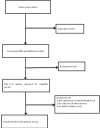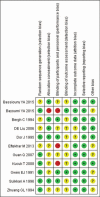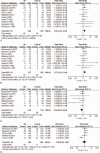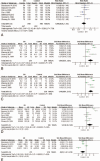The influence of different growth hormone addition protocols to poor ovarian responders on clinical outcomes in controlled ovary stimulation cycles: A systematic review and meta-analysis
- PMID: 28328856
- PMCID: PMC5371493
- DOI: 10.1097/MD.0000000000006443
The influence of different growth hormone addition protocols to poor ovarian responders on clinical outcomes in controlled ovary stimulation cycles: A systematic review and meta-analysis
Abstract
Background: Growth hormone (GH) is used as an adjuvant therapy in in vitro fertilization and embryo transfer (IVF-ET) for poor ovarian responders, but findings for its effects on outcomes of IVF have been conflicting. The aim of the study was to compare IVF-ET outcomes among women with poor ovarian responders, and find which subgroup can benefit from the GH addition.
Methods: We searched the databases, using the terms "growth hormone," "GH," "IVF," "in vitro fertilization." Randomized controlled trials (RCT) were included if they assessed pregnancy rate, live birth rate, collected oocytes, fertilization rate, and implantation rate. Extracted the data from the corresponding articles, Mantel-Haenszel random-effects model, or fixed-effects model was used. Eleven studies were included.
Results: Clinical pregnancy rate (RR 1.65, 95% CI 1.23-2.22), live birth rate (RR1.73, 1.25-2.40), collected oocytes number (SMD 1.09, 95% CI 0.54-1.64), MII oocytes number (SMD 1.48, 0.84-2.13), and E2 on human chorionic gonadotropin (HCG) day (SMD 1.03, 0.18-1.89) were significantly increased in the GH group. The cancelled cycles rate (RR 0.65, 0.45-0.94) and the dose of gonadotropin (Gn) (SMD -0.83, -1.47, -0.19) were significantly lower in patients who received GH. Subgroup analysis indicated that the GH addition with Gn significantly increased the clinical pregnancy rate (RR 1.76, 1.25-2.48) and the live birth rate (RR 1.91, 1.29-2.83).
Conclusion: The GH addition can significantly improve the clinical pregnancy rate and live birth rate. Furthermore, the GH addition time and collocation of medications may affect the pregnancy outcome.
Conflict of interest statement
Funding: This study was funded by the National Natural Science Foundation of China (Grant No. 81100421), National Natural Science Foundation of China (81601343), Top Six Talent Peaks Program of Jiangsu (2014-WSW-080), the National Science Foundation of Yangzhou (YZ2014050), and the National Science Foundation of Yangzhou (YZ2016110). All authors have no conflicts of interest.
The authors have no conflicts of interest to disclose.
Figures





References
-
- Keay SD, Liversedge NH, Mathur RS, et al. Assisted conception following poor ovarian response to gonadotrophin stimulation. Brit J Obstet Gynaecol 1997;104:521–7. - PubMed
-
- Papathanasiou A, Searle BJ, King NMA, et al. Trends in ‘poor responder’ research: lessons learned from RCTs in assisted conception. Hum Reprod Update 2016;0:1–4. - PubMed
-
- Sunkara SK, Tuthill J, Khairy M, et al. Pituitary suppression regimens in poor responders undergoing IVF treatment: a systematic review and meta-analysis. Reprod Biomed Online 2007;15:539–46. - PubMed
-
- Surrey ES, Schoolcraft WB. Evaluating strategies for improving ovarian response of the poor responder undergoing assisted reproductive techniques. Fertil Steril 2000;73:667–76. - PubMed
-
- Lashen H, Ledger W. Management of poor responders in IVF. Hum Reprod 1999;14:1919–21. - PubMed
Publication types
MeSH terms
Substances
LinkOut - more resources
Full Text Sources
Other Literature Sources
Medical

